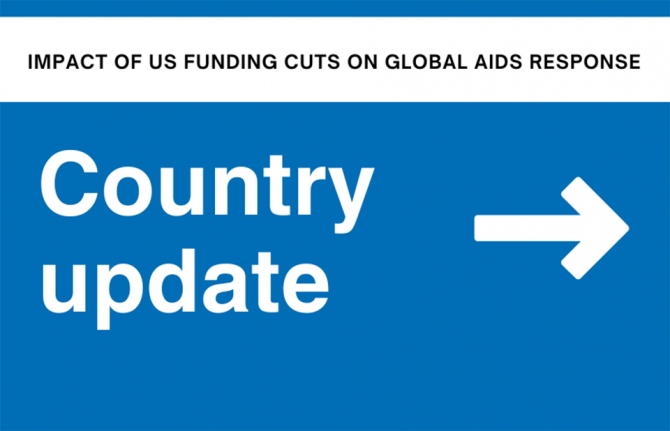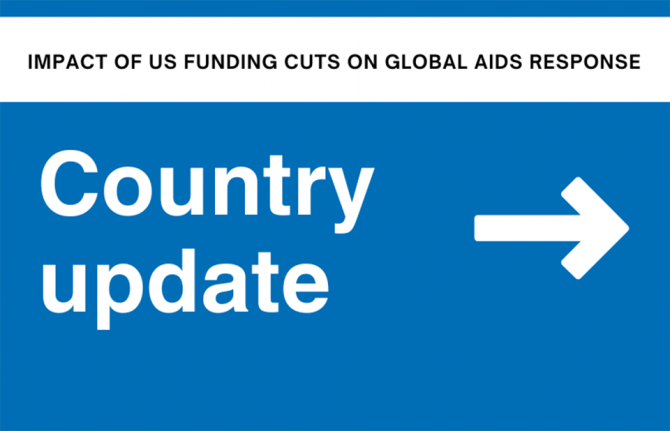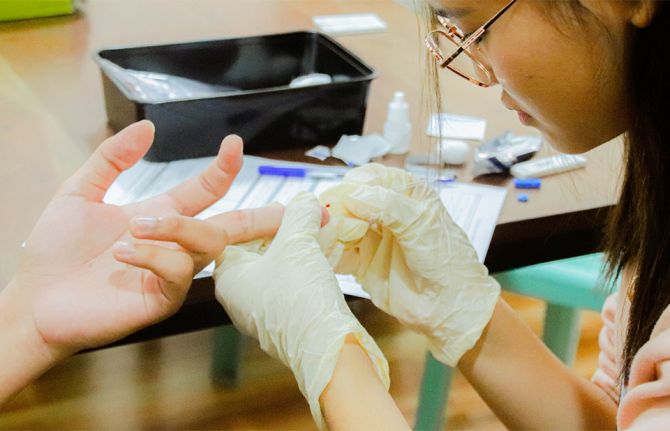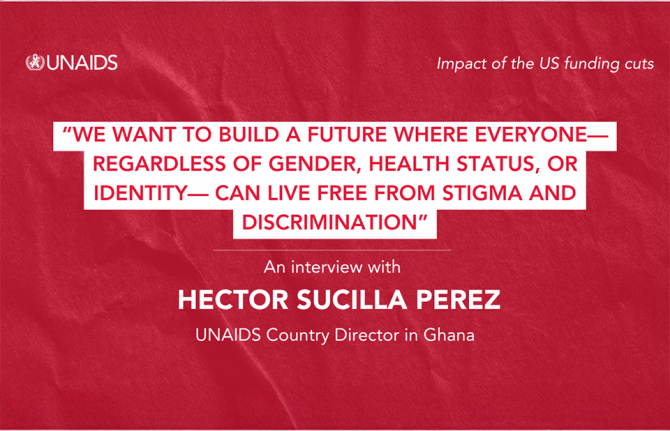

Feature Story
Impact of US funding cuts on HIV programmes in Lesotho
14 April 2025
14 April 2025 14 April 2025Immediate risks or disruptions
- Vertical transmission services: An impact assessment conducted by the Ministry of Health, supported by UNICEF, confirms:
- Staffing gaps and shortages: There are significant staffing gaps affecting the availability of counsellors and other essential personnel.
- Testing disruptions: HIV testing services are disrupted, with specific issues such as a non-operational point-of-care machine in one district.
- Overcrowding: There is overcrowding in health facilities across all 10 districts due to staff shortages.
- Data quality issues: Data completion and quality are severely impacted as nurses struggle with using the registers.
- Resource allocation: The field assessment highlights the need for reprogramming of, and additional, resources.
- Service restart challenges:
- Partners who received waivers to restart services are facing difficulties in resuming operations effectively.
Politically relevant updates
- Government actions:
- A national resource mapping exercise has been launched by the Ministry of Health to guide reprogramming within the health sector. This exercise aims to provide a detailed understanding of available resources to support broader health sector interventions.
Related resources
Region/country
Related


Feature Story
Impact of US Funding Cuts on HIV Programmes in Côte d'Ivoire
09 April 2025
09 April 2025 09 April 2025Immediate Risks and Disruptions
- The US waiver allowing the continuation of lifesaving treatment and the court order allowing CDC-led activities to resume resulted in the resumption of the provision of antiretroviral treatment (ART) and prevention of vertical transmission of HIV.
- Activities for key populations, HIV-prevention, human rights, and community-led monitoring (CLM) have ceased.
- Contracts providing support to national civil society organizations (CSOs) have been terminated. National implementing partners like Espace Confiance, ASAPSU, and Blety ceased all activities supported by the USAID in March.
Politically Relevant Updates
- Government actions:
- The government has requested a rapid analysis of the financial gap following the cessation of US funding (internal report not yet available).
- The Ministry of Health issued a directive on service continuity, ensuring access to ARV care and other services.
- An antiretroviral order planning meeting has been held. ARV stocks have been secured for the next 4 months and an order schedule for the remaining part of the year has been agreed.
The CIPHIA (Côte d'Ivoire Population-based HIV Impact Assessment) survey has resumed, with final report availability expected by the end of September 2025.
- Civil Society Response:
- Civil society organizations have launched an advocacy campaign, including a letter to the president, press conferences, and media interviews calling for continued support and funding for HIV programmes, including sustainable financing of civil society and community-led responses
Temporary measures have been implemented to maintain services and staff in certain NGOs, including minimal service, part-time contracts, and salary reductions. However, these measures cannot be sustained in the absence of additional funding. CSO are working on developing funding proposals.
- UN Involvement:
- The UN has met with civil society and is in ongoing dialogue with CSOs re the impact and mitigation measures.
- UNAIDS has produced and shared short videos of interviews with community leaders and beneficiaries; they have garnered more than 4000 views on social networks.
- Government officials have been informed, sensitized, and mobilized on the impact and the need for a coordinated and systematic response. This included using UNAIDS GOALS impact model on new HIV infections and HIV related deaths in absence of a comprehensive response.
- An analytical technical note on the impact of the US funding cuts and recommendations for mitigation strategies was produced and shared with government officials.
- The UNAIDS Rapid AIDS Financing Tool (RAFT) has been shared and promoted with various government offices, including the Directorate General of Health, Directorate of Health Economics, National AIDS Control Program, and the prime minister's office.
- Resources have been mobilized from various sources to ensure the continuation of critical UNAIDS activities: Expertise France for technical assistance on the sustainability roadmap, reprogramming of CDC cooperation agreement activities for approximately 150,000 USD (Expertise France, BMGF, GF/GC7 grant).
Related resources
Region/country
Related


Feature Story
Impact of US funding cuts on HIV programmes in Ghana
08 April 2025
08 April 2025 08 April 2025Commodity stock report
The commodity stock report elaborated by the Ghana Health Services/Ministry of Health under the umbrella of the Global Fund Logistics Support Project, provides insights into the national availability of key HIV and other health commodities. The recently released information for the month of February contains the below mentioned information on the availability of antiretroviral treatment and other HIV commodities.
- Antiretroviral treatment:
- Tenofovir/Lamivudine/Dolutegravir (TLD 300/300/50mg): Fully available nationwide with a slight overstock - 12.85 months of stock.
- Dolutegravir 50mg: Fully available with overstock – 18.19 months of stock.
- Tenofovir/Lamivudine (300/300mg): Overstock - 41.62 months of stock
- Lopinavir/Ritonavir (200/50mg): Fully available with overstock - 17.83 months of stock. Nevertheless, there is only 64% availability across regional medical stores, with stockouts in Ashanti, Bono and Bono East regions. Distribution to these regions aims to stabilize supply.
- Dolutegravir 10mg: Adequate stock - 10.85 months of stock with 91% availability at regional medical stores and teaching hospitals. Allocation and distribution measures aim to stabilize supply.
- Abacavir/Lamivudine (120/60mg): Critically low stock levels at 1.22 months of stock with 64% availability at regional medical stores; new shipments are pending clearance.
- Paediatric and syrup formulations: Zidovudine/Lamivudine tablet stock is high (25.27 months of stock). Nevirapine syrup is fully available (6.38 MoS), there are lower stock levels of Zidovudine syrup (3.17 months of stock), with an incoming shipment expected.
- HIV and syphilis diagnostics:
- OraQuick HIV test kits: Availability improved from 91% in January to 100% in February (4.93 months of stock).
- HIV first response & syphilis combo test kits: Consistently at 100% availability (6.45 and 9.54 months of stock respectively).
- Rapid diagnostic tests SD bioline: Stockouts in Ashanti and Bono, with critically low in-country stocks (0.87 months of stock). A shipment of 75,240 kits is expected in April 2025.
Politically relevant updates
- Ghana Medical Trust Fund: The Government of Ghana has launched the Ghana Medical Trust Fund (Mahama Cares Initiative). This presidential initiative, launched in mid-March, aims to provide financial support for people with chronic diseases. The Ghana AIDS Commission (GAC) and the UNAIDS Country Office have initiated discussions to potentially include HIV as one of the health conditions to be covered by this mechanism. This alternative has been also included as part of the options to explore in Ghana’s Sustainability Roadmap document. UNAIDS is providing support to the GAC to amend the terms of reference for the HIV Sustainability Technical Working group to include the documentation of the impact of US funding cuts as part of the mechanisms to streamline the coordination, monitoring and mitigation of the situation.
- Human rights steering committee meeting: On 26 March, the Ghana AIDS Commission convened the 7th Human Rights Steering Committee Meeting, chaired by the Acting Director General. The meeting included key national and international partners, including UNAIDS, to advance the human rights agenda within the HIV response. The Committee recommended strategic engagement with the PEPFAR Coordinator to get accurate programmatic and financial information on human rights-related interventions supported by the US.
- Courtesy visit from PEPFAR team to the Ghana AIDS Commission: On 3 April, a PEPFAR team delegation led by the PEPFAR Coordinator for West Africa II Region (Ghana, Liberia, Sierra Leone, and Mali), paid a courtesy visit to the Acting Director of the Ghana AIDS Commission and his team. This was the first official meeting of the PEPFAR Team with the Ghana AIDS Commission since January. Initial discussions on the relevance of PEPFAR’s support to the HIV response in Ghana took place.
- Bilateral Meeting UCD-Ghana and PEPFAR Coordinator for West Africa II: On 4 April, a bilateral meeting was held at the UNAIDS country office between the UNAIDS country director and the PEPFAR Coordinator for West Africa II Region (Ghana, Liberia, Sierra Leone, and Mali). The iscussion focused on the critical need to maintain US support in Ghana to ensure programmatic sustainability, to achieve the 95-95-95 and 10-10-10 targets, and to continue the collaboration in support of the process led by the Government of Ghana to develop the HIV Sustainability Roadmap.
Coordination with Civil Society Organizations and communities.
On 3 April, UNAIDS Country Office initiated a series of bi-weekly meetings with community-led organizations to assess the impact of the US funding cuts on their work, including their focus on human rights, stigma and discrimination, and HIV prevention. The community-led organizations agreed to design a tool to map out the projects previously funded by the US Government that have stopped and to find alternatives to close the gaps and maximize efficiency in the delivery of programmes.
Related resources
Region/country
Related


Feature Story
Impact of US funding cuts on HIV programmes in Kenya
04 April 2025
04 April 2025 04 April 2025Immediate risks and disruptions
- Access to Kenya electronic medical records system: There are media reports indicating that aggregate health data are not accessible through the Kenya health information system (DHIS2).
- Commodity availability: Short-term commodity availability has improved, with HIV commodities now being available at facilities. However, human resources for health remains impacted.
- Service impact: Services for HIV, TB, malaria, immunization, nutrition, and family planning programmes are still affected. HIV prevention programmes have been paused or scaled down.
Politically relevant updates
- Impact of US Government funding cuts: The Kenyan Government released a comprehensive report on 24 March detailing the impact of the US Government funding cuts. Key recommendations include:
- Immediate actions:
- Establish an emergency health contingency fund.
- Mobilize domestic resources and reallocate the national budget.
- Begin high-level diplomatic negotiations with the United States.
- Medium-to-long-term actions:
- Strengthen public-private partnerships.
- Expand universal health coverage and implement health insurance reforms.
- Develop local pharmaceutical manufacturing.
- Set up a donor coordination platform with real-time monitoring and mapping.
- Create a structured contractual and legal framework to ensure resilience.
- Immediate actions:
- Government convening and mitigation measures: The National AIDS & STI Control Programme and the National Syndemic Diseases Control Council are planning to take an in-depth account of the situation at the county level on HIV treatment for adults and children.
Impact highlights
- Civil society impact: Kenyan civil societies, led by the Kenya Legal and Ethical Issues Network, have demanded clarification from the Office of Data Protection Commission on measures taken to safeguard health data and ensure compliance with relevant data protection laws.
- Community-led initiatives: ISHTAR, a key populations-led organization, received funding from other donors to continue with community-led monitoring work until the end of March.
- UN response: The UNAIDS country office, in partnership with the National AIDS & STI Control Programme and the National Syndemic Diseases Control Council is developing a proposal to mobilize resources from the China International Development Cooperation Agency for HIV and other sexually transmitted infections prevention activities.
Documented impact on services
All facilities/service points providing antiretroviral treatment are working at a reduced capacity. The UNAIDS country office has received reports from the field that HIV commodities are now available at the facilities. The country has currently adequate HIV commodities and those that were running low at health facility level were flagged on 14 March 2025 by the Cabinet Secretary Ministry of Health for distribution by the US supported procurement agency. No stockouts are foreseen in the next 3-6 months. However, human resources for health remains impacted.
Related resources
Region/country
Related


Feature Story
Impact of US funding cuts on HIV programmes in Togo
03 April 2025
03 April 2025 03 April 2025Immediate risks and disruptions
- Documented impact on services:
- Reduced availability of PrEP; suspension of HIV prevention education and awareness campaigns, and decreased access to HIV testing and counselling services for key populations.
- Disruption of the distribution of condoms, lubricating gel, antiretroviral drugs.
- All programmes on stigma and discrimination funded by the US Government have stopped.
- Disruption of HIV data collection:
- Cessation of data entry at PEPFAR sites, leading to a disruption in HIV data collection.
- Decrease in viral load testing:
- Viral load testing has decreased due to the slowdown in services at PEPFAR-funded sites.
- Stock concerns:
- Concerns about stock-out of HIV test kits within 3-6 months.
- Condom stocks are sufficient for 1-3 months; but there is a need for 800,000 condoms per month, with funding for procurement being a concern.
- International NGO-run services:
- All services run by international NGOs funded by US Government/PEPFAR have stopped.
Politically relevant updates
- Government actions:
- The National Programme for the Fight against HIV/AIDS and Sexually Transmitted Infections has conducted an analysis of service provision, commodity availability, and human resources.
- The National Council for the Fight against AIDS sent an information note to the President and the Ministry of Health.
- Advocacy efforts with other technical and financial partners to mobilize resources to fill gaps.
- Integration of HIV services into other health services is being worked on by the government.
- The government is funding 55 operational sites and 142 mediators.
- Civil society impact:
- Civil society has assessed financial, programmatic, and human resources gaps.
- Consultation meetings with the National Program for the Fight against HIV/AIDS and Sexually Transmitted Infections and implementation of a roadmap.
Impact
- Impact of USAID funding suspension:
- 11,000 people living with HIV will lose access to antiretroviral treatment.
- 24,769 people living with HIV will no longer have access to viral load testing.
- 10,000 individuals, including pregnant women and their children, will miss out on testing.
- 203 project staff are facing technical unemployment since January 2025.
- Current financial gaps:
- Togo faces a financial gap of 2.1 billion FCFA (West African CFA franc) for 2025, with 1.6 billion FCFA needed for antiretroviral medications and reagents.
- Proposed solutions:
- Increase the state budget line for health from 2.5 billion FCFA to 5 billion FCFA.
- Include HIV as a chronic disease in the universal health insurance mechanism to ensure sustainable domestic funding.
UN response
- The UNAIDS Country Office is meeting with networks of people living with HIV and key populations, and a country-level task team is in place, including representatives from people living with HIV and key population networks.
Related resources
Region/country
Related


Feature Story
Impact of US funding cuts on HIV programmes in Burundi
02 April 2025
02 April 2025 02 April 2025Immediate Risks and Disruptions
- Funding Gap: An immediate input gap of 6,436,448 USD has been identified; these funds are required to cover the purchase of antiretroviral therapy (ARVs), tuberculosis (TB) prevention products, essential drugs for opportunistic infections (OIs), rapid tests, and transport costs.
- Service Disruptions: The US funding cuts have disrupted services provided by ICAP, a major implementing partner financed by the US, and its two main civil society organization sub-recipients, affecting approximately 10,290 people living with HIV (PLHIV), including 528 pregnant/breastfeeding women, and 5,512 people most at risk of exposure to HIV.
- Impact on Key Services: An evaluation carried out by the stakeholders estimated the impact of the US funding cuts as follows: Services impacted by more than 25% include: pre-exposure prophylaxis (PrEP), distribution of condoms and lubricants, health promotion and prevention services, services for key vulnerable populations (KVPs), prevention and management of sexual and gender-based violence (SGBV), community-led monitoring (CLM), and data management and health information systems.
Politically Relevant Updates
- Suspension of US Government Funding: the 90-freeze of US foreign assistance has put on hold at least 6,872,000 USD, representing support for more than 50% of the HIV activities needed to ensure continuity of service for people living with HIV.
- Impact on Data Management: The cuts have compromised data production and management, with over 711,500 USD needed to support the management of electronic medical record systems and the strengthening of the national health information system.
- Civil Society Impact: Community organizations involved into Community Led Monitoring (CLM) are heavily impacted, with three implementing partners (CAPES+, BUNERELA, CBF+) reporting a funding impact of 230,574 USD on their operating budget and on their human resources. Additionally, more than 167 staff from service provider organizations have had their contracts affected, and 30 peer educators working with 200 infected injecting drug users have had their contracts terminated.
The US funding cuts have had a profound impact on HIV programmes in Burundi. For example, ICAP, an implementing partner financed by the US, provided comprehensive coverage of prevention, treatment, and care as well as HIV viral load monitoring to around 61,000 PLHIV (out of an estimate of 81 000 PLHIV in the country) through the Baho Mbeho project in 349 health facilities across 18 provinces. The disruption of these services has left thousands of individuals without essential support, highlighting the critical need for sustained funding and international cooperation to ensure the continuity of HIV programmes.
Recommendations and mitigation measures resulting from consultations and an impact workshop include:
- Organize a joint field impact assessment mission under the lead of the Ministry of Health (MOH).
- Set up a crisis management group and a mitigation plan.
- Map US-funded interventions/projects.
- Set up a team to leverage the UNAIDS Rapid AIDS Financing Tool (RAFT).
- Model impact according to various scenarios and reprogram/reprioritize interventions.
- Meet with development partners to discuss funding and support.
- Include HIV in primary health care, universal health coverage (UHC), and social protection.
These measures aim to address the immediate risks and disruptions, ensuring that HIV programmes can continue to provide vital services to those in need.
Related resources
Region/country
Related


Feature Story
Impact of US funding cuts on HIV programmes in Kenya
01 April 2025
01 April 2025 01 April 2025Since the US cut their foreign assistance, the Government of Kenya has provided leadership to ensure continuity of HIV care at various levels, in consultation with different partners. Recently, the Ministry of Health, led by the Cabinet Secretary, convened high-level meetings with County Governors, the parliamentary Health Committee, Development Partners for Health and communities to discuss the impact of the US funding cuts and make recommendations.
In the meetings, the following were agreed/discussed:
- Establishment of a multi-sectoral monitoring and coordination committee to regularly monitor the impact and manage information and communication
- Seek emergency access to HIV/TB/Malaria commodities in-country and information on orders in high seas and manufacturers
- Seek emergency financing for identified gaps in commodities and HRH
- Mobilize county governments for re-purposing of entire health workforce to mitigate HIV/TB/Malaria service gaps and community initiatives
- Propose policy actions for Health Systems Resilience in the face of dwindling aid-based development funding for healthcare
- Seek consensus for policy reviews and pathways for mainstreaming and integration of vertically funded programs into public health service delivery mechanisms
Service Delivery
The country has witnessed resumption of HIV prevention and treatment services, however not at full scale. For instance, community prevention and treatment services such as community outreach services, peer led awareness and education and differentiated service delivery have been impacted. Additionally, sample networking for viral load testing and early infant diagnosis remains impacted.
Due to the unstructured and abrupt nature of the integration of HIV services into outpatient clinics, there have been reports of incidences of stigma and discrimination towards people living with HIV and key populations including fears of involuntary disclosure and lack of confidentiality.
Supply Chain Management System
The Government has assured it has adequate stocks of HIV health products and technologies in the country. The commodities that were running low at health facility level were flagged off for distribution by the CS Ministry of Health through USAID supported procurement agency (MEDS). The consignment included antiretroviral drugs, HIV testing kits, male condoms, early infant diagnosis and viral load testing reagents.
Strategic Information
The Kenya Health Information System (KHIS) that captures national aggregate HIV program data has been down due to the US funding cuts. This has hampered the availability of data for program reporting and other reporting processes, including GAM and mini-GAM (HIV services monthly reporting).
Civil Society and Communities’ Impact, Resilience, and Response
- Civil society and communities continue to convene to discuss the impact and develop mitigation strategies.
- Communities of PLHIV and Key populations, through their formal and informal networks, are offering peer led services such as counselling, treatment information, peer referrals and linkages to address the gaps.
- They have also led high level advocacy with the media that has influenced government decisions to address the impact of the Stop work order.
- Communities and Civil Society have played a key role in providing useful information, including lived experiences on the impact of the funding and services interruptions, that have been used by the international community to advocate for continued support by US Government.
- Communities have widened their resource mobilization efforts from non-traditional donors to sustain their initiatives that have been impacted by the Stop Work Order
UN Response
- UNAIDS is supporting communities in analysis and review of the community-led assessment tool to assess the impact of the funding disruptions on delivery of services.
- UNAIDS convened communities and civil society to discuss the funding disruptions and develop mitigation measures. The outcome of the meeting has led to the advocacy for the domestic funding and media engagements to influence actions by governments to bridge the gaps in HIV services as a result of the US funding cuts.
- UNAIDS provides technical assistance to communities and civil society on advocacy efforts as well sustaining interventions that have been impacted by the US funding cuts.
- UNAIDS supported the creation of compelling outputs from GOALS modeling to demonstrate the impact of funding shifts on new HIV infections and mortality based on prevention and treatment coverage scenarios which could result from the funding shifts. These outputs will be used to supplement ongoing advocacy efforts.
- Some of the UN agencies have initiated joint programing through co-funding initiatives to mitigate the impact of the US funding cuts.
Related resources
Region/country
Related


Feature Story
Impact of US funding cuts on HIV programmes in El Salvador
28 March 2025
28 March 2025 28 March 2025Immediate Risks or Disruptions
- Stockouts:
- Pre-Exposure Prophylaxis (PrEP): The HIV Program Unit of the Ministry of Health has only a four-month supply of PrEP remaining. However, The Global Fund authorized them to use remaining funds to purchase PrEP.
- The USAID PASMO project, which implemented PrEP through private clinics, has not returned; they have only been authorized to work on offering self-testing.
- Service Capacity:
- HIV Testing & Treatment: antiretroviral therapy provision continues, but facilities are operating at reduced capacity.
- HIV Prevention Services: Reduced capacity is affecting key populations such as gay men, sex workers, people who use drugs, and transgender people.
- At the moment, the greatest impact is on prevention, as only 11 of the 30 promoters who supported doctors in initiating PrEP for key population users in the VICITS clinics have been rehired. Therefore, their workload has been overloaded by assigning them three VICITS clinics per promoter.
- Comprehensive HIV Care Clinics: Projects supporting 20 out of 24 clinics were reinstated, allowing the return of 90% staff, including doctors, laboratory staff, pharmacies, data entry clerks, and community liaisons. The care and treatment areas are recovering despite the impact of the three-week pause that led to more than 1,200 antiretroviral therapy dropouts.
- Human rights, key and vulnerable populations: All programs on stigma and discrimination have stopped affecting key populations, adolescent girls and young women, and people living with HIV.
- Civil Society Organizations (CLOs):
- CLOs are experiencing significant challenges, including service reductions or suspensions, staff losses, and funding cuts, which limit their ability to advocate for key issues. Additionally, their capacity to collect and report data has decreased due to a lack of funding for monitoring activities. As a result, many CLOs face the risk of closure or severe reductions in services.
Politically Relevant Updates
- Government and UN Coordination:
- UNAIDS conducted an early assessment and has been continuously updating it, presenting the impact to the UN country team.
- A country-level task team is in place, with representation from REDSAL (a network of people living with HIV) and Colectivo Alejandría (representing key populations).
- Funding and Support:
- The USAID Global Health Supply Chain Program Procurement and Supply Management (PSM) resumed operations, providing support for supply chain projections and management.
- The Data for Implementation (DATA.FI), funded by USAID in collaboration with Palladium and the Department of Epidemiology at Johns Hopkins returned to assist with data analysis in the case registration system.
Related resources
Region/country
Related


Feature Story
Impact of US funding cuts on HIV programmes in Panama
28 March 2025
28 March 2025 28 March 2025Immediate Risks and Disruptions
PEPFAR Programme Delays:
- PEPFAR PrEP delivery to 2,500 people among key populations, mainly men who have sex with men, was canceled. However, as of 14 March PrEP provision services for key populations (MSM mainly) have been re-established and the MoH has taken over distribution.
- Human resources and transport for viral load samples at ARV clinics provided by PEPFAR were canceled, affecting several cities:
- Panama City: 8,100 people
- Colón: 1,300 people
- Pacora: 300 people
- Ngäbe-Buglé population: 1,400 people, where HIV prevalence is high.
- HIV commodities: Stocks available with minimal disruption.
- Prevention of vertical transmission (PVT) and pediatric HIV services: No services affected.
- HIV prevention: Disruptions in access, reduced capacity for HIV prevention services, including HIV counseling and testing, primarily affecting sex workers, men who have sex with men, and transgender people.
- Condom promotion and demand generation activities: Impact noted on public sector, social marketing programs, NGOs, and community distribution.
- Data collection: Continues at some facilities and service points, along with some data quality control and collation.
- Study suspension: The suspension of a study on recent HIV diagnoses and the halt in laboratory sample transportation have further limited essential diagnostic and monitoring services
- All programs on stigma and discrimination have stopped, affecting key populations. Communities have collected data on human rights issues, including increased stigma and discrimination.
- Disruptions noted in HIV prevention programs affecting particularly men who have sex with men, sex workers and transgender people
- Human resources and transport for viral load samples at ARV clinics provided by PEPFAR were canceled, affecting several cities:
Service Disruptions:
Politically Relevant Updates
- Government Actions:
- The Panamanian government began expanding friendly services to key populations to absorb the demand for PrEP that US funding was covering.
- Adjustments were made to ARV services to temporarily cover the human resources provided by US funding, however, this impacted the quality and timeliness of service provision.
- Civil Society Impact:
- Community-based organizations (CLOs) are struggling but have alternative funding sources; however, they have noted a reduced ability to participate in policy discussions.
- UN Response:
- A country-level task team has been established but does not include representatives from people living with HIV and key population networks.
- UNAIDS is collecting information from PEPFAR partners but has not received clear responses due to canceled field worker contracts.
Related resources
Region/country
Related


Feature Story
Impact of US funding cuts on HIV programmes in Myanmar
28 March 2025
28 March 2025 28 March 2025Immediate Risks and Disruptions
- Service Closures: US-supported facilities and international NGO-run services have shut down. Some antiretroviral therapy service facilities have closed, and there is no clear referral system in place.
- Supply Chain: antiretroviral supplies, HIV test kits, viral load tests, other lab tests, and male and female condoms are available with minimal disruption to distribution. However, condom stock levels are unavailable or not tracked.
- Service Disruptions: PrEP and HIV testing services have been disrupted. Prevention of vertical transmission and pediatric HIV services remain unaffected.
Civil Society Impact and Response
- CLOs: Community-led organizations (CLOs) face a reduction or suspension of services and have limited ability to advocate for key issues. Despite struggles, some CLOs have alternative funding sources.
UN Response
- Mitigation Actions: The UN country team has been engaged in actions to mitigate the impact of the USG shift. UNAIDS coordinated PEPFAR implementing partners to assess the impact.



